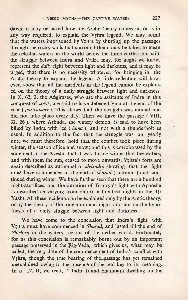Page 446 - Lokmanya Tilak Samagra (khand 2)
P. 446
VEDIC MYTHS-THE CAPTIVE WATERS 227
dawn, it may be asked how the Arctic theory comes in, or is in
any way required, to explain the Vritra legend. We may admit
that the waters imprisoned by Vritra by shutting up the passages
through the rocky walls that surround them, may be taken to mean
the celestial waters in the world below the three earths; but still,
the struggle between Indra and Vritra may, for aught we know,
represent the daily fight between light and darkness, and it may be
urged, that there is no necessity whatever, for bringing in the
Arctic theory to explain the legend. A little reflection will how-
ever, show that all the incidents in the legend cannot be explain-
ed on the theory of a daily struggle between light and darkness.
In X, 62, 2, the Angirases, who are the assitants of Indra in this
conquest of cows, are said to have defeated Vala at the end of the
year ( parivatsare ). This shows that the struggle was annual and
did not take place every day. Then we have the passage (VIII,
32, 26 ), where Arbuda, the watery demon, is sa1d to have been
killed by Indra with ice ( hima ), and not with a thunderbolt as
usual. In addition to the fact that the struggle was an yearly
one, we must therefore, hold that the conflict took place during
winter, the season of ice and snow; and this is corroborated by the
statement in the Avesta, that it was during winter that the waters,
and with them the sun, ceased to move onwards. Vritra's forts are
again described as autumnal or shdradi!z showing that the fight
must have commenced at the end of sharad ( autumn ) and con-
tinued during winter. We have further seen that there are a hundred
night-sacrifices, and the duration of Tishtrya's fight with Apaosha
is described as varying from one to a hundred nights in the Tir
Yasht. All these incidents can be explained only by the Arctic theory,
or by the theory of the long autumnal night, and not on the hypo-
thesis of a daily stuggle between light and darkness.
We have come to the conclusion that Indra's fight with
Vtitra must have commenced in Sharad, and lasted till the end of
Shishira in the watery regions of the nether world. Fortunately
for us this conclusion is remarkably borne out by an important
passage preserved in the .Rig-Veda, which gives us, what may be
called, the very date of the commencement of Indra's conflict with
V{itra, though the true bearing of the-.passage has yet remained
unexplained owing to the absence of the real key to its meaning.
In II, 12, II, we read, "Indra found Shambara dwelling on the

